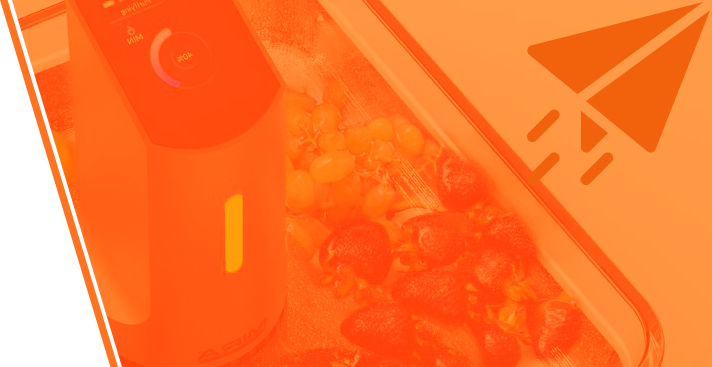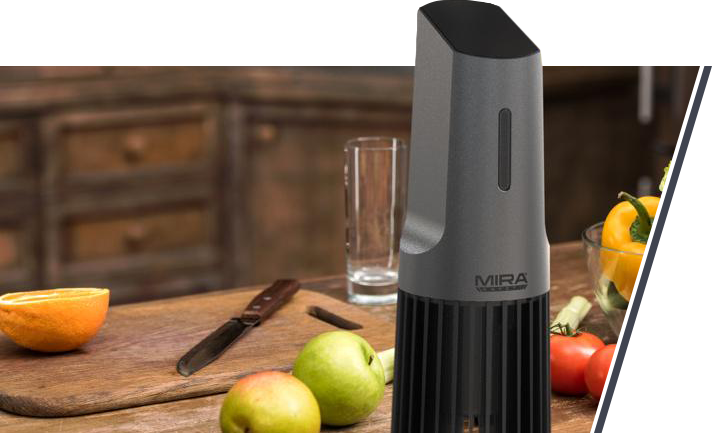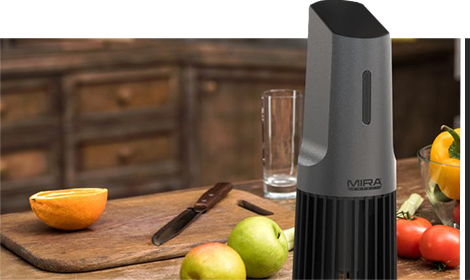TABLE OF CONTENTS
-
01
What is Staph Food Poisoning?
-
02
Where Does Staph Come From
-
03
What Does an Outbreak of Staph Food Poisoning Look Like
-
04
Why Cooking Won't Stop Staph
-
05
What Are the Symptoms of Staph Food Poisoning
-
06
How to Prevent Staphylococcal Food Poisoning
-
07
Is There a Better Way to Clean Meat and Produce
-
08
How to Use the Detoxifier to Clean Staphylococcal Bacteria from your Food
-
09
Final Thoughts on Staph Food Poisoning

We have all found ourselves with a turning stomach soon after a meal. As the queasy feeling leads to nausea, you realize that something you ate was terrible. There is no turning back at this point, and you know there is only one of two ways this nightmare will end.
Foodborne illness is widespread in the United States. It is primarily a product of poor personal hygiene or foods prepared or held in a temperature danger zone. When these foods are served to people, the rapidly growing bacteria are consumed and infect the person.
Staphylococcus aureus is a type of bacteria that can cause foodborne illness. We rarely know what caused the foodborne illness, but everybody knows when they are dealing with it. It's never a pretty situation.
Foodborne illness does not just originate in restaurants. Sometimes you can bring produce and meat into your home, which can cause foodborne illness. We never want to be the person that infects our family and, in turn, ourselves from cooking and preparing contaminated food in our homes.
Staph food poisoning can happen at home because staph is a naturally occurring bacteria in the environment. We will take a deeper look at staph food poisoning in this article. We will also teach you the best method for cleaning your produce and meat at home.
What is Staph Food Poisoning?
Food poisoning is rarely diagnosed because the symptoms are short-lived and very similar. There is a broad spectrum of bacteria and viruses that cause foodborne illness, and staph is one such bacteria.
Staphylococcus aureus is an interesting type of food poisoning because it is not necessarily the culprit in the symptoms or outbreaks. The staph bacteria make a toxin that infects the person and causes the symptoms in those who consume the bacteria in your typical staph food poisoning.
Healthy people do not often suffer from the effects of too much staph bacteria in their bodies. The toxin is a different story; it takes about 24 hours for your body to filter it out. That is why we suffer short-lived symptoms.
Where Does Staph Come From?
Staphylococcal Bacteria exist naturally in the world around us. This bacteria is widespread, and the CDC suggests that about 25% of people and animals have Staph bacteria on their skin. This means that it can be transferred to food or surfaces and replicate there rapidly.
When food is infected with staph, it will not have a specific look or odor, which makes staph food poisoning such a tricky thing to deal with.
This puts staph bacteria in close contact with the food that we eat. It could be food prepared and served in restaurants, vegetables picked and shipped in America, or even salads prepared in your own home.
At all levels of the food system, you want there is potential for contamination. However, if you clean food thoroughly at home, you can avoid infecting your family.
What Does an Outbreak of Staph Food Poisoning Look Like?

Even though staph food poisoning symptoms can clear up quickly, there is still the chance of outbreaks. These usually occur from food served to many people from the same source.
Many people share the infected food, and each quickly develops symptoms. In an outbreak, you will get a rapid diagnosis to determine what kind of foodborne illness you are dealing with.
Outbreak of Staphylococcal Food Poisoning Associated with Precooked Ham -- Florida, 1997
On September 27, 1997, a community hospital in northeastern Florida notified the St. Johns County Health Department about several persons who were treated in the emergency department because of gastrointestinal illnesses suspected of being associated with an everyday meal. This report summarizes the investigation of the outbreak by the Florida Department of Health; the findings implicated staphylococcal intoxication as the cause of illness among some persons who attended a retirement party on September 26, 1997.
Self-administered questionnaires were distributed to the 125 attendees to document food histories, illnesses, and symptoms. A case was defined as nausea and/or vomiting in a person who attended the party or consumed food served and became ill within 8 hours after eating. Leftover food was collected and submitted for laboratory analysis. Food preparers were interviewed about the purchase and preparation of food served at the party.
Outbreak of Staphylococcal Food Poisoning Associated with Precooked Ham -- Florida, 1997 (cdc.gov)
Why Cooking Won't Stop Staph
Staph bacteria are just like other types of bacteria. They will die when cooking temperatures reach 165 degrees. The problem with staph food poisoning is that the toxin excreted from the bacteria is actually what gets you sick.
Even when the bacteria are killed off by cooking, you can still get sick because you are dealing with lots of dead bacteria that put out toxins inside your body. This toxin sends your body into a response that brings on those terrible food poisoning symptoms.
This is because your body is trying everything it can to get the toxin out of your system. The only way you can avoid this overabundance of toxins in your body is to be sure that the food you are buying, preparing, cooking, and eating is safe from staph bacteria.
What Are the Symptoms of Staph Food Poisoning
Staph food poisoning has a rapid onset. You can begin to see symptoms as soon as 30 minutes after consumption. However, symptoms can also take 8 hours to start showing, depending on the infection and the individual.
Symptoms of Staph Food Poisoning
-

Sudden Onset of Nausea
-

Vomiting
-

Stomach Cramps
-

Diarrhea
The good news is these symptoms can be short-lived. Most symptoms will be resolved within 24 hours but those 24 hours are not going to be fun.
Can I Be Sure It’s Staph?
You will see the symptoms of staph food poisoning resolve within 24 hours. Some tests can be done to diagnose staph food poisoning, but most people don't go to that length because the symptoms are bad but short-lived.
Tests will be done if there is a staph food poisoning outbreak. The staph outbreak can come from one source and spread to multiple customers of a food service establishment like a restaurant.
In the two examples of outbreaks above, enough people were affected by the staph food poisoning from sampled food. They tested it for various bacteria and viruses that could cause a rash of similar symptoms.
This is the only way a staph food poisoning diagnosis could be 100% positive.
How to Prevent Staphylococcal Food Poisoning
The best defense against staph food poisoning is ensuring that your hot food is kept at safe temperatures. You must understand the temperature danger zone and keep your food out of those temperatures.

The temperature danger zone is between 40 degrees and 140 degrees. Cold food must be kept below 40 degrees, while hot food must be kept above 140 degrees. The temperature danger zone is between 40-140 degrees.
Bacteria grow best within the range of the temperature danger zone. Bacteria are a lot like us, and we also enjoy temperatures between that range. So, to keep your food safe from staph food poisoning, you need to manage the temperature of your food.
Always wash your produce and your hands when you are preparing food. The bacteria can be on the produce or delivered to the food from your hands. So washing your hands with soap and hot water thoroughly is one of the best ways to ensure that you do not spread harmful bacteria.
Wash your produce thoroughly. You know that produce can be covered in harmful and even carcinogenic pesticides. All produce should be cleaned before being prepped or served. Spraying or rinsing with water might be your only option, but that is better than nothing.
Only prepare food if you are well. This is especially true if you suffer from diarrhea and vomiting symptoms. You can quickly spread staph bacteria to the food you are serving if you are sick and dealing with the symptoms of an outbreak.
Finally, wear gloves if you have cuts or abrasions on your fingers or hands. Cuts and scrapes could expose food to blood and blood-borne illness and other bacteria that congregate at a wound site. You can spread all kinds of bacteria this way if you are not careful.
Is There a Better Way to Clean Meat and Produce
Rinsing with water is only one method of cleaning produce; some people rinse their meat too. However, we are in an age of massive technological advances. MIRA Safety has been working on making your food safer at home so that when you serve your family, you know the produce and meat you used were the freshest and the cleanest they could be.
The age of using chemicals to clean is coming to an end. We know that even organic cleaning chemicals can affect us and our food. It's time to move these dangerous manufactured chemicals out of our lives for a cleaner and healthier solution.
How to Use the Detoxifier to Clean Staphylococcal Bacteria from your Food

Washing produce can be more complex than washing your hands. These days we buy better produce than ever, sometimes from our backyard or a local farm. That is the best way to get our food, but we must also be careful about contamination.
Eliminating staph bacteria from your fresh foods can be very hard if you do not have the appropriate cleaning means. Fresh herbs, lettuces, and greens can be almost impossible to get spotless.
It might be time to recruit some help. There is a better way to clean produce, and it is available to the general public. Have you ever used a detoxifier before? Well, this cleans food, utensils, and even cutting boards like nothing you have ever seen!
The DTX-1 Oxidizing Food Detoxifier is a revolution in food safety. We are ever concerned about our food and what goes into it, and we worry about what is sprayed on top of it. The last thing we need is another chemical to add to it.
That is why this kitchen tool is so effective. It adds nothing to your food and, unlike salad spinners or hand washing, does not damage your food in any way. Delicate greens can get as clean as potatoes because of the oxidizing technology that surrounds the food and kills all the bacteria, removes pesticides, and makes food safe to eat.
The DTX-1 is built on a durable, hypoallergenic plastic base and has an easy-to-use LCD touchscreen. This machine offers up to 4 separate modes of cleaning, all of which would kill off any traces of staph food poisoning.
Not only can you use the DTX-1 to clean your food, but it works equally well to clean things like rings, watches, and other personal effects that can be hard to clean.
How Does it Work?

The DTX-1 might be the ultimate solution to staph food poisoning and foodborne illness. Truth is your right!
According to the CDC, each year, roughly 1 in 6 Americans (or 48 million people) will get sick, 128,000 will be hospitalized, and 3,000 will die due to foodborne diseases.
Of course, the real question is how the DTX-1 Food Detoxifier defends against pesticides, harmful heavy metals, hazardous chemicals, bacteria, and viruses. The answer is simply oxygen.
The whole process starts with a large bowl of water, and it must be large enough to hold all the food you want to get clean. Then you are going to sink the DTX-1 into the water.
When you turn on MIRA's new Oxidizing Detoxifier, you can use the preset duration or in manual mode; you get all the time you want. Set the intensity and the course. The water then begins to fill with oxidizing bubbles that filter through your food, breaking up chemicals and contaminants.
Once the process has run its course, everything you pull out of the water will be 100% clean. It's as simple as putting your food in a large water bowl and pressing a button.
Rather than just washing your produce with water, you can put your confidence in a combination of ultrasonic waves and oxidation to ensure numerous contaminants, including staph bacteria, are removed from the food you serve at home.
Final Thoughts on Staph Food Poisoning
There are some aspects of a staph food poisoning outbreak that you cannot control. You cannot step foot in every kitchen that you eat at. You can only put faith in the fact that they are being managed well and are using proper personal hygiene practices. Of course, the food must also be held safely and out of the temperature danger zone.
At least at home, you can be safe from food poisoning, contaminants, bacteria, and even pesticides. In the safety of our house, we get to manage personal hygiene and food safety at large.
Of course, some types of meat and produce are hard to wash thoroughly. Having the DTX-1 Food Detoxifier by Mira Safety is the final piece to your home food safety puzzle. This is the one piece of equipment you can use to ensure your family stays safe from contaminated food. It doesn't matter if the food comes from a farmers market, grocery store, or backyard; you can make it clean and safe for your family.





